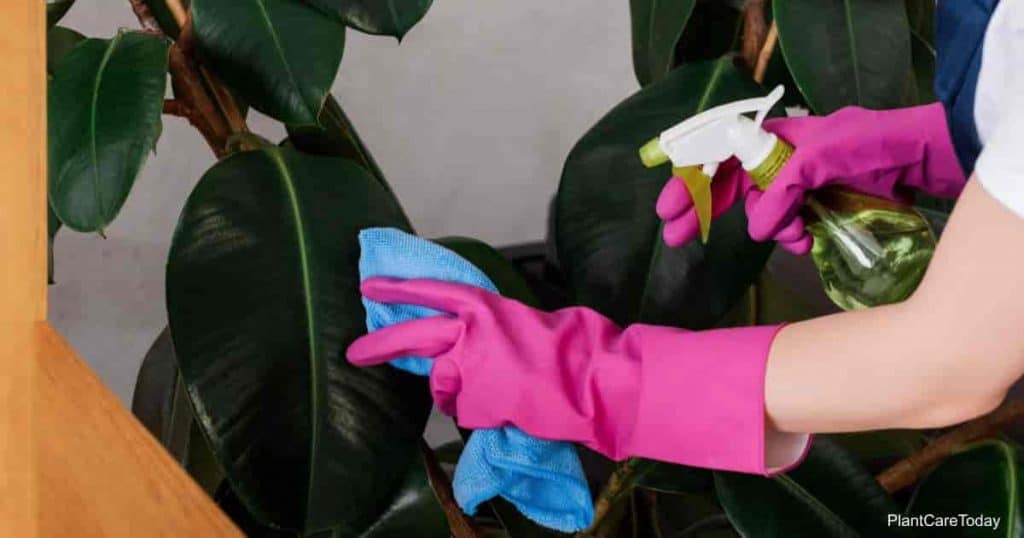Plants have a lot of things in common with humans. One of these is the fact that outdoor plants use the rain to get clean leaves, but when indoors, plants require artificial means.
Since your indoor jungle probably won’t get up and walk to the shower, you will need to give your plants a sponge bath occasionally. This is where a cleaning plant leaves with neem oil becomes a great option.

This is especially true of indoor plants with large leaves, such as monstera, snake plants, fiddle leaf figs, philodendrons, and succulents plants.
An accumulation of dust can not only dull any variegation but may interfere with the plant’s ability to photosynthesize.
An all-natural leaf shine with Neem oil could be the answer to this problem. But did you know that there are different uses for neem oil with some extra benefits?
How to Make Neem Oil for Leaf Shine
The common question is: Does neem oil make leaves shiny?
Yes, neem oil can be used to make leaves shiny.

However, making and using neem oil as a leaf shine is a little bit different from the foliar sprays you might be used to.
There are also some special considerations you’ll need to remember when using a neem leaf shine.
Differences Between Leaf Shine and Foliar Spray
Leaf Shine products generally don’t use neem oil in their foliar spray since the main goal isn’t to fight infestations.
Additionally, you won’t be covering the entire plant’s foliage (and blooms) with the mixture.
Foliar sprays are left on the plant while shines are wiped off, meaning the shine will be less effective against an active infestation than a foliar spray treatment.
Benefits of Using a Neem Leaf Shine
Aside from using neem oil to shine plant leaves, it’s an effective repellant.
Being a popular repellant for aphids, neem oil, even in a more diluted form, can help combat common pests and insects on contact.

Another benefit of neem oil is that it prevents larvae from hatching
The cloth, which will end up having neem all over it, will help dislodge and kill plant pests.
Additionally, the neem will affect any external fungal or bacterial infections.
Drawbacks of Using Neem Oil to Clean Leaves
Can you use neem oil to clean plant leaves?
Yes, neem oil can be used to clean plant leaves as it has insecticidal and fungicidal properties that help remove pests and debris.
Neem foliar sprays generally remain on a plant for 45 minutes to an hour, giving them time to suffocate infestations, but a shine is immediately wiped off.
This means it’s far less effective against an infestation (but will still help in the earliest stages of infestation).
Always test a tiny area of your plant 24 hours before using neem to ensure the plant isn’t allergic or over-sensitive.

Additionally, the leaf shine can increase a plant’s risk of sunburn.
Avoid using the shine on plants exposed to direct sunlight, and treat such plants only after there is no longer direct sun hitting the plant.
You should also avoid using the shine on window plants during the hottest part of the day.
Neem Oil Leaf Shine Recipe and Application
If you decide that it is time to use neem oil to clean plant leaves, here’s how.
The recipe for a neem tree leaf shine isn’t too different from that of a foliar spray.
Begin by mixing 1 tablespoon of pure castile soap or Dawn dish soap into a room-temperature distilled gallon of water.
You’ll probably want to skip using insecticidal soap since it won’t be on the plant long enough to be of benefit.
Next, add four teaspoons of clarified hydrophobic neem oil to your emulsion and mix well.
- As this is a leaf shine, we suggest using a .5 to 1% percent Azadirachtin content.
- Pour the leaf shine spray mix into a spray bottle.
- To apply, you will want to do each leaf individually when possible.
- Place a microfiber cloth or any soft cloth behind the leaf and give it a spray.
- This is to help protect juvenile leaves, which tend to be more sensitive to chemicals and sunburn.
- Gently use the damp cloth to wipe down the leaf of excess water, leaving behind a nice sheen and no dust or grime.

Repeat this as often as necessary, although a plant in a generally clean home will only need to be wiped down 1 to 2 times per month on a regular basis.
After the process, wash your hands and store the leaf shine neem oil solution somewhere safe in a cool, dry place. It is not for human consumption.
